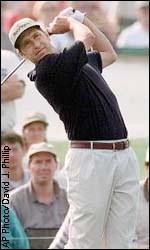| ESPN NETWORK: ESPN.COM | NFL.COM | NBA.COM | NASCAR ONLINE | ABCSPORTS | FANTASY | THE STORE | INSIDER |

| ||||||||||||||||
| ALSO SEE ESPN Golf Online's Masters coverage | ||||
| SPORTS NBA | ||||
|
Friday, Apr. 9 6:27pm ET Harig: Olazabal on the prowl By Bob Harig Special to ESPN Golf Online | |
AUGUSTA, Ga. -- The irony is easy to miss. While Greg Norman was suffering through a very public collapse, Jose Maria Olazabal sat at home dealing with his own agony.
The 1996 Masters will always be remembered for Norman's disaster, a final-round 78 that denied him the green jacket he seemingly should have won several times. Nick Faldo overcame a six-shot deficit, and the golf world was stunned.
 | |
| Olazabal has made just two bogeys over the first two rounds at Augusta. |
Few were thinking of Olazabal that day. He was at home in Spain, and his golf career was in limbo. Two years earlier, he had triumphantly captured The Masters. Watching Norman blow the tournament, he wondered if he'd ever get the chance to deal with that kind of pain.
"I couldn't do a lot of things," said Olazabal, who leads The Masters after the second round. "I couldn't walk. I had to stay at home. I listened to music. Read books. Watched TV. That's all I could do."
Olazabal was suffering from a mysterious foot ailment that was so serious he believed his career might be over. In fact, it became so bad that he wondered if he'd every be able to walk again.
Although it didn't affect his swing, Olazabal could not get through a round of golf walking, certainly not the four or five days required to play in tournaments. His condition went undiagnosed for some 18 months.
It took a visit to a German homeopathic specialist who determined that the pain in his feet came from a lower back hernia. Others, including doctors at the Mayo Clinic, had said it was rheumatoid arthritis. The German doctor prescribed back and toe exercises, and today, Olazabal is pain free.
Olazabal, 33, who still lives in the same home where he grew up next to a golf course in Fuenterrabia, Spain, won his third tournament back on the European Tour in 1997, and earned his 17th European title last year.
His last victory in the United States came at the 1994 World Series of Golf.
The foot problems began a year later, and by 1996, Olazabal was in such bad shape that he didn't even make the trip to Augusta.
"You always try to be positive in a situation like that," he said. "I was thinking that one day I will be back there. Now, I try not to think too much about what happened. You cannot live in the past. Obviously, it has helped me to appreciate things more."
Norman can certainly relate. That tournament had a big affect on him, too.
"It changed my life," Norman, 44, said of the 1996 disaster. "There's a huge amount of support from people out there on a global basis. My locker is full of letters this week. You still get people writing to you from 1996 ... You get to see and appreciate other things in life more than just the game of golf."
This weekend, they will stalk one of golf's most coveted titles. The man who just a short time ago could barely walk negotiated Augusta's hilly terrain with a 6-under 66 to take a one-shot lead over Scott McCarron and a three-shot advantage over Norman and Lee Janzen.
The Spaniard's rise to the top is no shock. He's finished in the top-15 here in seven of his past nine Masters, including his 1994 victory.
"I just put myself in a nice situation," Olazabal said. "I know that there are two more days to go, tough days. Two shots is nothing. We're far from over.
"I've said this before. We all know, the tournament will start on the back nine of the last day. So I'll try to keep on doing a good job the next couple of days."
Bob Harig, who covers golf for the St. Petersburg Times, writes a golf column every Tuesday for ESPN Golf Online.
| ESPN INSIDER | COMMUNITY | MY INSIDER | BACKSTAGE
Copyright 1995-99 ESPN/Starwave Partners d/b/a ESPN Internet Ventures. All rights reserved. Do not duplicate or redistribute in any form.ESPN.com Privacy Policy (Updated 12/21/98). Use of this site signifies your agreement to the Terms of Service (Updated 01/12/98). | ||||